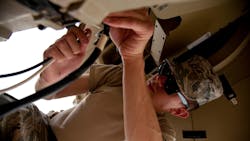Ability to process battlefield data over the network becomes a high priority among services and contractors
ORLANDO, Fla. – Success against a technologically advanced enemy in the future will require much different thinking — about the tools we use in war and how they work together. Defense News reports. Continue reading original article
The Military & Aerospace Electronics take:
9 March 2020 -- The most important element of future combat will not necessarily be warships, combat vehicles, aircraft or satellites. It will be a battle network that connects them to work in unprecedented harmony.
Pentagon leadership and the heads of each of the military services all have come to the same conclusion: data is the principal currency of future warfare, and the military that is able to collect, process, and share data faster than opponents will hold a huge advantage.
The U.S. military today cannot share data in a seamless and simultaneous way between the Army, Air Force, Navy, Marine Corps, or the Space Force. Weapons are built by defense contractors who often hold data as proprietary information. Very often the platform made by one contractor won’t communicate or share data with a system made by another. And the same often goes for sharing data with our allies and partners.
John Keller, chief editor
Military & Aerospace Electronics
